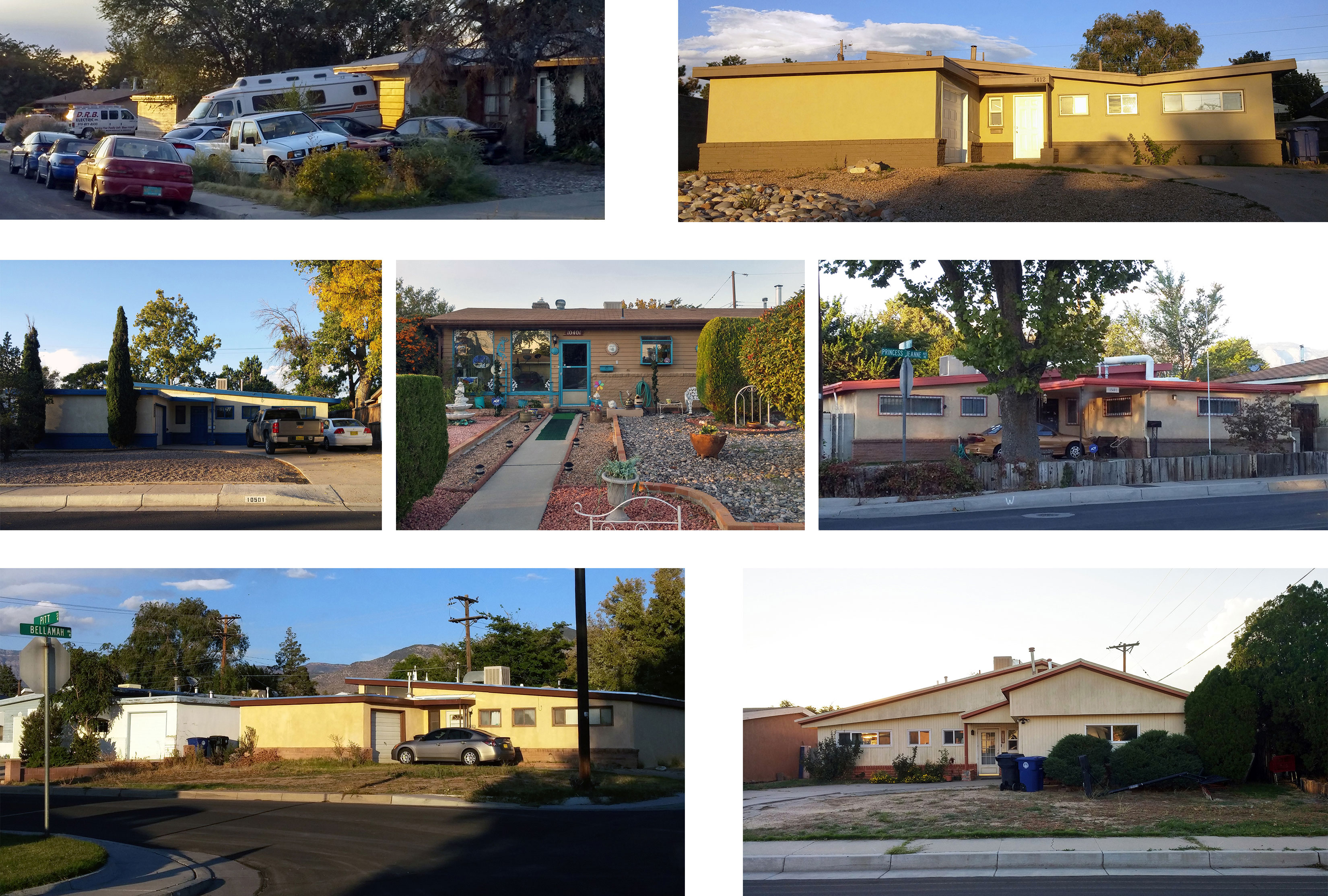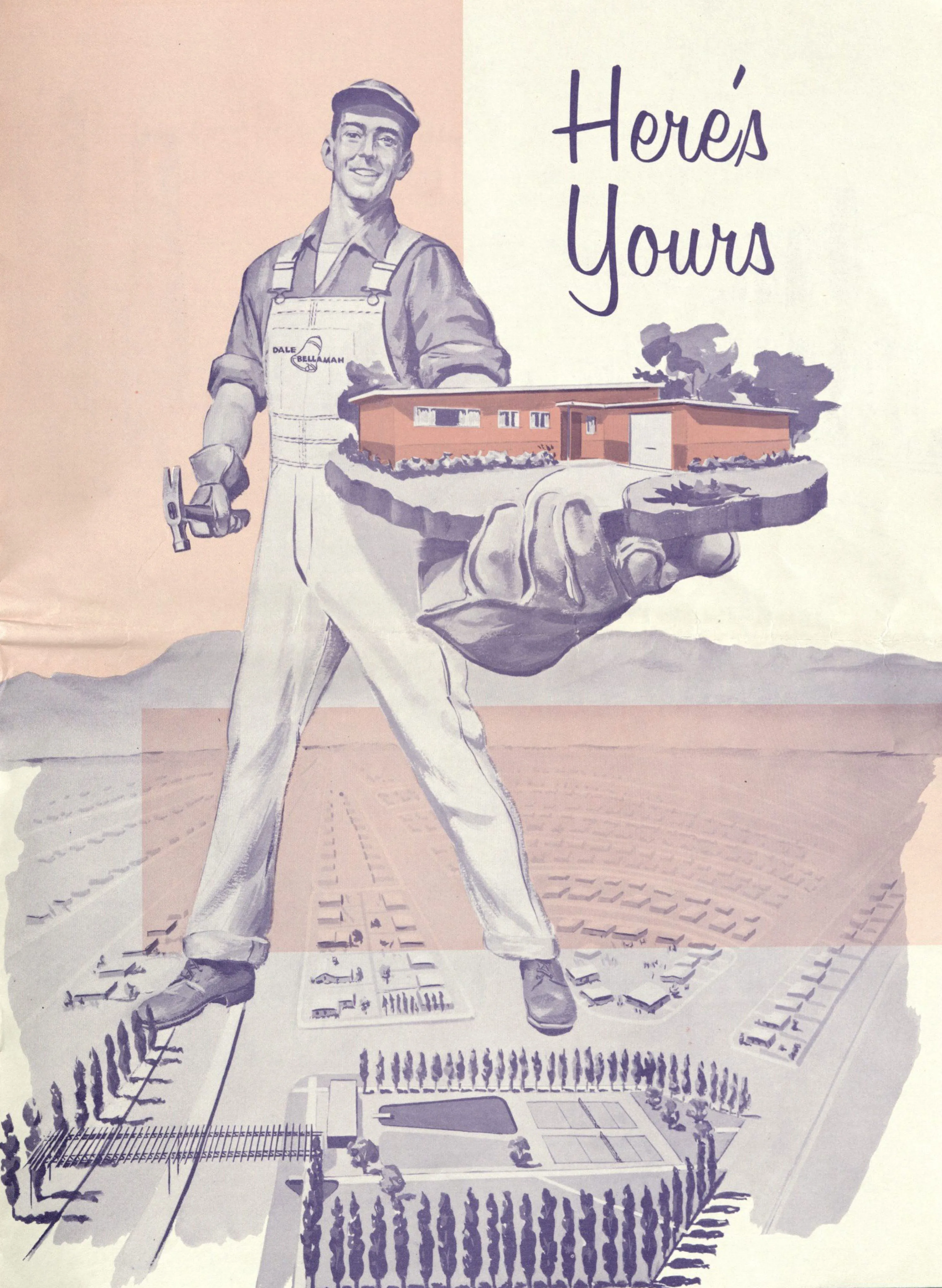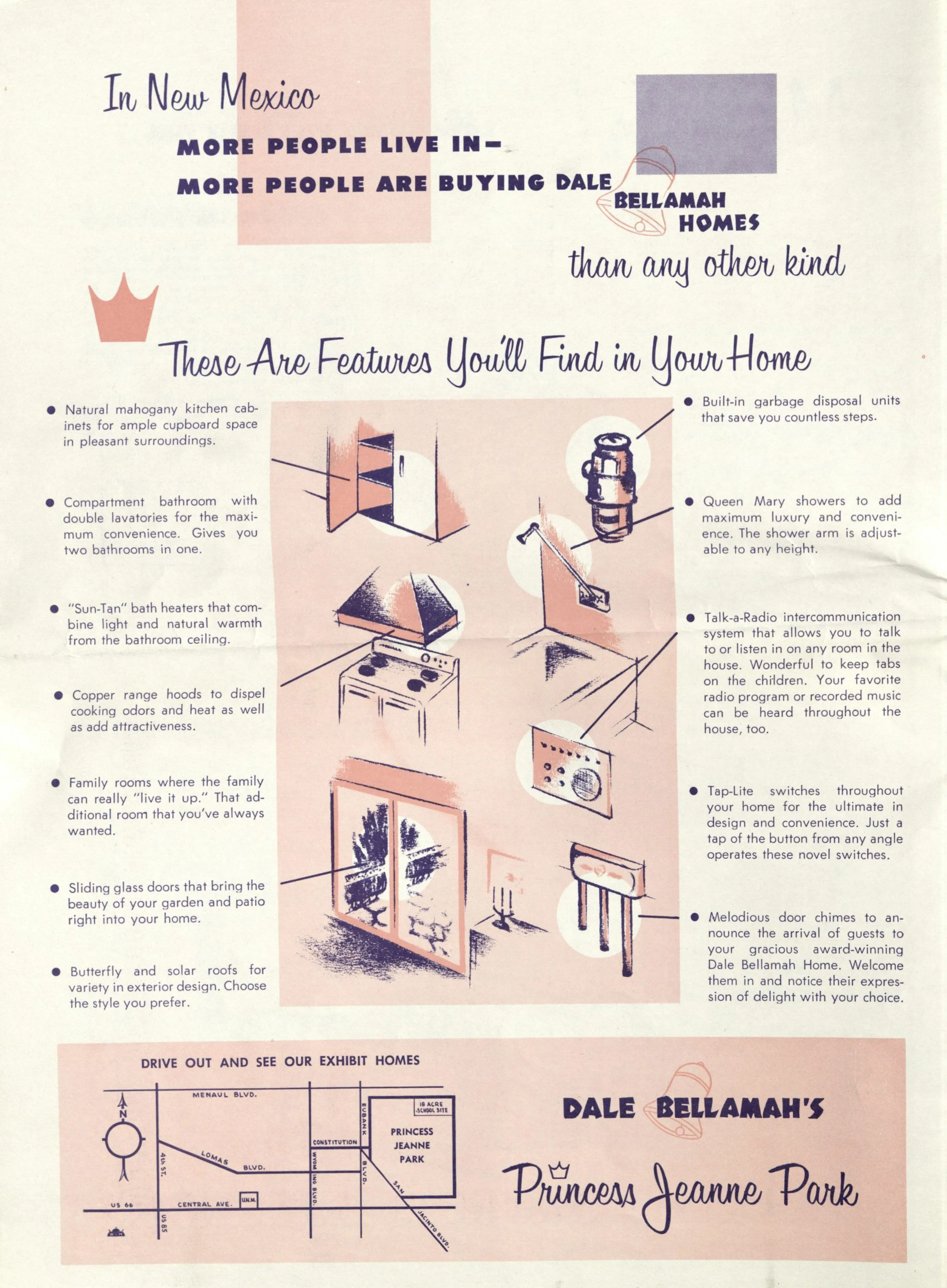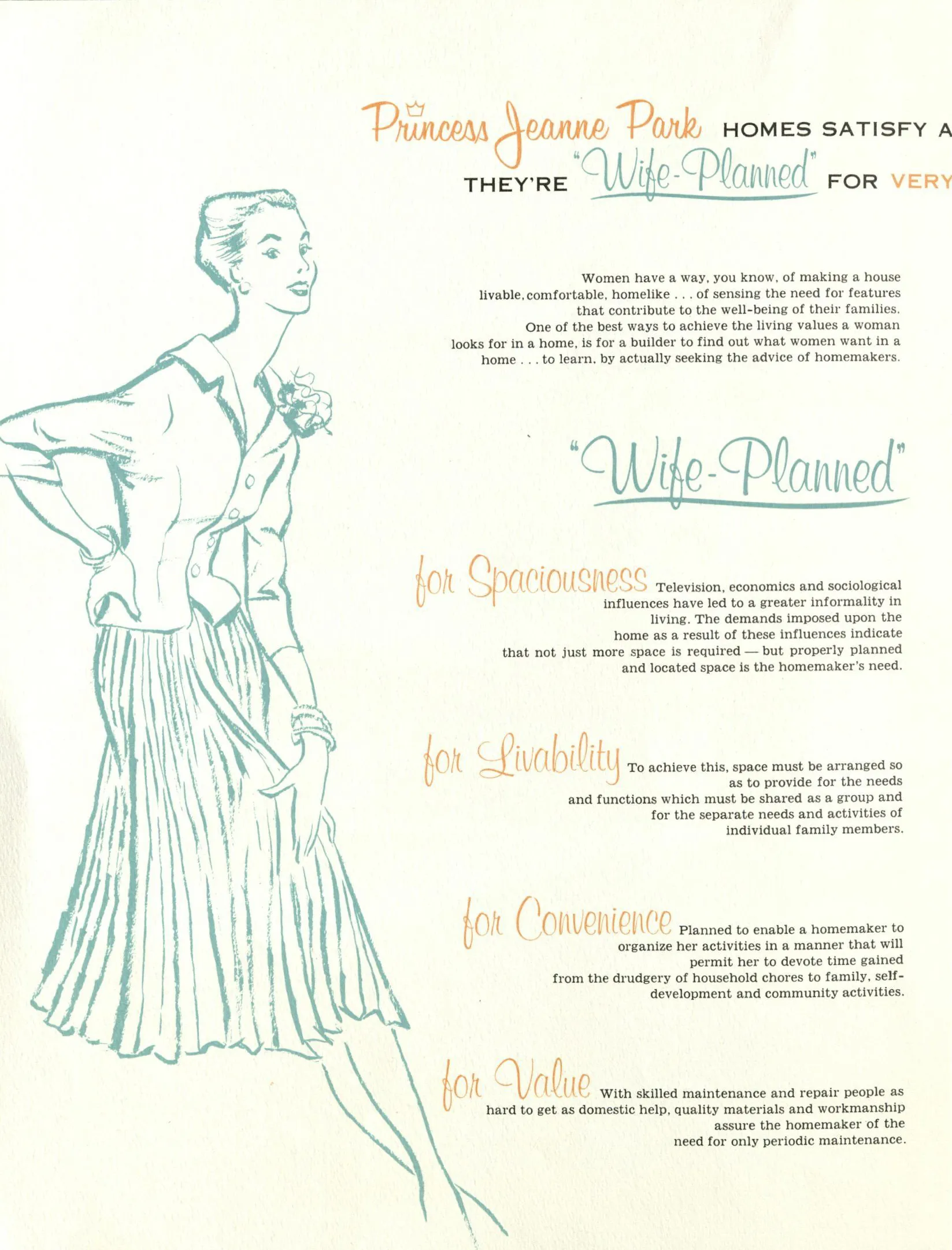1954
Dale Bellamah Homes
Case study by:
Cameron Townsend,Fri Oct 09 2015
Princess Jeanne Park

In 1954 Albuquerque builder Dale Bellamah began construction on Princess Jeanne Park in the Northeast Heights of Albuquerque. By the time the development reached completion, it included 1600 homes, a large swimming pool, a park, tennis courts, and a community center.1 The homes featured a range of modern appliances, such as washing machines, refrigerators, and in-sink garbage disposals. Princess Jeanne Park catered to young families and newlywed couples looking to settle down and enjoy the benefits of the mild climate and booming economy of postwar Albuquerque. The development serves today as an accurate depiction of the economic and social trends of the time for both Albuquerque and the nation. The advertisements for Princess Jeanne Park in particular call attention to the clearly defined and restrictive gender roles of the era and give readers a clear picture of the target market for the development.
Following the end of World War II, America experienced great changes. In the place of military mobilization and food and supply rationing came an era of abundance and of mass production and consumption. As GIs returned home, they married, bought houses, and started families. Many of them found jobs in the city, but sought homes and land they could call their own away from crowded urban centers. The “American Dream” evolved to include not just the ability to provide for oneself and a family, but to own a house, a yard, and a car―preferably better than the family next door. As historian Robert Turner Wood describes, “With their youthful energy, their accumulated savings and their veterans benefits, they were in good position to take advantage of and contribute to the postwar boom.”2 And contribute they did. As a result, America experienced economic and population growth like never before.
The West, especially, was on the receiving end of much of the postwar growth. By 1970, the West passed the Northeast to become the most urbanized part of the country.3 The widespread attitude that technology would greatly improve lives, new tools of urbanization, and new policies encouraging growth fueled the new suburban age. Western cities rushed to take advantage of this new growth and promote themselves as big cities. As historian John Findlay notes, “Throughout the West, municipal boundaries raced outward to accommodate the growing numbers of inhabitants, and in the process many towns… lost their customary shapes and orientations.”4
This rapid expansion was readily evident in Albuquerque, whose population increased by more than 5 times between 1940 and 1970.5 World War II played a major role in Albuquerque’s growth. The city received bountiful government defense funding throughout and after the war, and people flocked in to take advantage of these new jobs and the mild climate. Many of those who came were stationed in Albuquerque and either stayed in the city or returned there after the war’s end.6 Due to the sudden population boom, Albuquerque experienced a housing shortage. As a result, the following decades saw a series of large additions to the city’s area. Large tracts of land were rapidly purchased, developed, annexed, and populated. Albuquerque pushed outward toward the east, away from the city center and into new suburban developments and shopping centers.
The housing shortage brought a need for large numbers of houses in a short period of time. Several builders in Albuquerque responded with a mass-production approach to housing, a strategy that had gained nationwide use. One of the most prolific and successful of these builders was Dale Bellamah. Bellamah, a native New Mexican, was born in 1915 to Lebanese parents in San Juan (now called Veguita). He left school at the age of 12 to work for Western Union and later the Santa Fe Railroad shops. He later earned a high school diploma and studied political science at the University of New Mexico. While attending college, he met and married his wife, Jeanne. She ran the liquor store that he started while he served in the military, starting in 1943.7
When Bellamah returned from war, he saw the potential for growth within the housing market and thus began his building career. In 1950, he purchased 327 acres in Albuquerque’s Northeast Heights and created the Bellamah Addition, which soon housed the Princess Jeanne Park development, named after his wife.8 Bellamah went on to become an influential member of Albuquerque’s political scene, serving on the City Planning Commission for 9 years, ending in 1957.9 By 1958, Dale Bellamah’s building firm was ranked the sixth largest in the world.10 His most famous saying was, “Look at a piece of land; see how it is today; dream how it could be tomorrow. If the dream is right, buy it.”11
Princess Jeanne Park represented Bellamah’s largest project, encompassing 1600 homes in its 300-plus acres.12 Taking shape as a complete community, the development also boasted a community center, swimming pool, park, and tennis courts.13 Original advertisements show the location of an 18-acre school site on the northeast corner and a shopping center on the southeast corner of the development as well.14 Homeowners could choose from roughly 10 to 15 model homes, which consisted of variations on a small number of base models. Buyers could choose the size, layout, and amenities included in their new home. Bellamah also offered homes in several architectural styles ranging from modern to Pueblo Revival in order to appeal to a greater number of buyers.
Dale Bellamah was not a modest man, and viewed himself as personally delivering the American Dream to families, which included capitalistic ideals and ownership of land and a house. An illustration resembling Bellamah can be seen on the cover of one brochure, a hammer in one hand and the other outstretched holding a home with a yard.
The title reads, “Here’s Yours.”15 Bellamah was determined to provide the home for everyman: quality, customizable homes at an affordable price. Like many postwar builders, he achieved relatively low prices by mass-producing limited designs in different sizes and finishes. This allowed buyers to feel a sense of ownership and pride, while attracting droves of middle-class families to the neighborhood.
The homes themselves featured an emphasis on modern amenities and new technologies. Mahogany kitchen cabinets, Sun-Tan bath heaters, electric kitchen ranges and vented range hoods, multi-room intercoms, and built-in garbage disposals are all listed in the original brochures.16
Also featured were new products such as linoleum and Formica.17 The homes reflected the era’s obsession with technology, the future, and consumption. One brochure proclaims, “Open the door on tomorrow.” Another states, “Everywhere you look the view is new when you have a new subdivision, new streets, and all-new models of all-new homes.”18 As Findlay explains, “Western cities offered little that was old or fixed; everything about them seemed to have arrived recently, and that included the family next door.”19
Princess Jeanne Park’s model homes featured a garage in the front, expansive green grass, and carefully placed landscaping in keeping with the automobile-centered, status-concerned lifestyle of midcentury. Brochures point out that Bellamah specially designed the curvilinear roads to slow traffic and protect playing children. Developers often used winding suburban roads to conjure images of comfort and home and reject similarities to short cuts, city streets, and commercial strip malls.20
Brochures advertising the homes and surrounding neighborhood also provide a fascinating look into the sanctioned roles of the average American middle-class family at this time, especially gender roles. During the war, women had to fill many of the jobs vacated by men serving in the military. Then, when the soldiers returned home, women moved back into the household to become homemakers and mothers. The husband returned to his place as the head of the household. Around this time, new inventions such as domestic washing machines became more commonplace. Now, women could – and were expected to – perform their homemaker duties within the confines of their own homes.
Several brochures describe Princess Jeanne’s homes as “wife-planned” with all the features a proper homemaker could desire. One brochure states, “Women have a way, you know, of making a house livable, comfortable, homelike… of sensing the need for features that contribute to the well-being of their families. One of the best ways to achieve the living values a woman looks for in a home, is for the builder to find out what women want in a home… to learn by actually seeking the advice of homemakers.” The implication, at least, is that the builder and engineers surveyed real wives to see what they wanted in homes.21
Yet despite this promised input, one can clearly see from this and other brochures that women in the neighborhood filled the traditional homemaker role, caring for their homes and children while their husbands were at work. Bellamah sought to attract wives to the homes and make them feel precious and adored. Model names include The Countess, The Baroness, and The Lady.22 Meanwhile, men in the brochures are represented as strong and masculine in the images and are portrayed as the provider and protector of their families. The wording of the brochures makes it clear that the husband would be the one purchasing the homes, the wife the one maintaining them.
These attitudes were present all over the nation, but Princess Jeanne Park is a particularly strong manifestation of the attitudes of the era. In fact, Princess Jeanne Park exhibits conventional 1950s suburban life so well that it was featured as part of an exhibit at the Smithsonian Museum, titled Science in American Life. The exhibit explored the interaction of science and society from 1876 to 2011.23 It opened in 1994, featuring a kitchen, living room, lawn, and patio, and a television featuring period programming―all modeled on Princess Jeanne Park.24
Together with its original advertising, Princess Jeanne Park illustrates the social and economic trends of the 1950s for both Albuquerque and the rest of the nation. It paints a revealing picture of postwar life and the rise of American suburbia. Even today, the development symbolizes major changes in the structure of the city of Albuquerque during its largest period of growth. It also tells the story of limited societal roles in an era of progress and innovation, particularly the gender roles that were expected in such neighborhoods. Today, Princess Jeanne shows her age in the changes that have taken place on her streets. The homes display a catalogue of additions and renovations and a greater diversity than before. Families no longer fit the traditional roles that were once expected here. Baby boomers, college students, and working families live side by side. Some mourn a perceived loss of community while others revel in the new diversity. Princess Jeanne Park will continue to serve as a picture of suburban life, then and now.
Footnotes
-
Robert Turner Wood, The Postwar Transformation of Albuquerque, New Mexico, 1945-1972 (Santa Fe, NM: Sunstone Press, 2014), 107-114. ↩
-
Ibid., 67. ↩
-
John M. Findlay, Magic Lands: Western Cityscapes and American Culture after 1940 (Berkeley, CA: University of California Press, 1992), 18. ↩
-
Ibid., 28. ↩
-
Findlay, 18. ↩
-
Ibid., 19. ↩
-
Wood, 106-109. ↩
-
Ibid. ↩
-
Ibid., 110. ↩
-
Ibid., 114. ↩
-
Eileen Welsome, “Dale Bellamah and His Princess Jeanne Ruled the Land,” Albuquerque Tribune, 28 September 1990, sec. A2. ↩
-
Wood, 109. ↩
-
“Albuquerque’s Historic Neighborhoods,”¡Colores!, VHS (New Mexico PBS, 2003). ↩
-
“It’s Been a Wonderful Year,” “Here’s Yours,” “Veterans, Not One Red Cent,” “Trick or Treat,” and “Who Done It,” ca. 1954, Box 1, Folder 1, Dale Bellamah Homes Records (MSS 646 BC), Center for Southwest Research and Special Collections, University of New Mexico, Albuquerque, NM [hereafter Dale Bellamah Homes Records]. ↩
-
“Here’s Yours,” ca. 1954, Box 1, Folder 1, Dale Bellamah Homes Records. ↩
-
Ibid. ↩
-
“Factoid Answer Key,” Albuquerque Historical Society, accessed September 20, 2015, http://albuqhistsoc.org/factoids/fAnswfactoid.htm. ↩
-
“Here’s Yours” and “All New Look”, ca. 1954, Box 1, Folder 1, Dale Bellamah Homes Records. ↩
-
Findlay, 36. ↩
-
Kenneth T. Jackson, Crabgrass Frontier: The Suburbanization of the United States (New York: Oxford University Press, 1985), 76. ↩
-
“Dale Bellamah Presents the ‘Wife-Planned’ Home for VIP’s”, ca. 1954, Box 1, Folder 1, Dale Bellamah Homes Records. ↩
-
“Here’s Yours,” ca. 1954, Box 1, Folder 1, Dale Bellamah Homes Records. ↩
-
“Science in American Life,” Smithsonian, accessed September 20, 2015, http://www.si.edu/Exhibitions/Details/Science-in-American-Life-164. ↩
-
“Factoid Answer Key,” Albuquerque Historical Society. ↩


